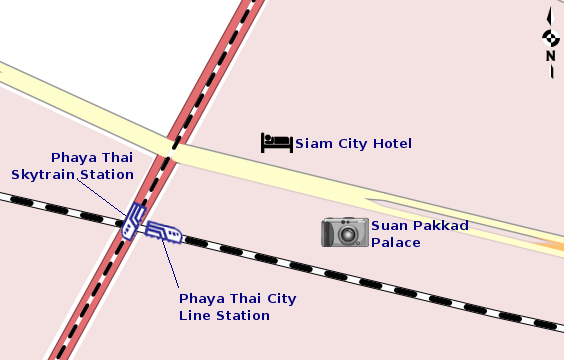The reception hall of the Palace
This collection of traditional Thai houses was brought together by Prince and Princess Chumbhot in 1952. Some of the houses belonged to the prince's family and all are more than a century old. The buildings and the collections became a museum on their death. The name Suan Pakkad literally translates to "cabbage patch" as the land was originally used for farming. The combination of traditional architecture, elegant gardens and a wide ranging collection make the museum worth a visit.
Like almost all traditional Thai houses, these are two stories high. The ground floors are more or less open while the second floor is where the main living quarters are. Some of the buildings here have had the ground floors enclosed to accommodate shops and exhibits, but most are quite close to their original state. Many of the buildings are linked by bridges on the second floor, so you can easily walk from building to building without going up and down a lot of stairs.
The buildings surround a garden designed with a Japanese feel, forming a semi-circle. Those in the front contain statues and other arts dating back as far as the 7th century. There are also artifacts from the daily life of royalty, including food containers decorated with mother-of-pearl and silver, betel nut boxes, clothing and ecclesiastical fans.
Other houses display archaeological finds from Ban Chieng, collections of rocks and minerals, shells, Benjarong pottery and other Thai ceramics. A special air conditioned building contains a collection of Khon masks used in the Thai classical dance depicting stories from the Ramakien.
The Lacquer Pavilion
Set a little off on its own at the edge of the garden is the "Lacquer Pavilion." The structure is more than 200 years old and formerly stood in a monastery on the Chao Phraya river just south of Ayuthaya. The late Prince Chumbhot purchased the building and moved it to these grounds, then had it restored. The pavilion consists of a "room within a room." A narrow corridor winds all the way around an inner room. The walls of the corridor are decorated in richly carved gilded wood. The interior of the inner room is decorated entirely in gold and black lacquer.
The Lacquer Pavilion is an extraordinary example of Thai art. This is the only one of the buildings that you have to take off your shoes before entering.
Next to the Lacquer Pavilion is a roofed building holding a barge designed to transport royalty. It used to sit in a canal that was part of the gardens but has been raised up to preserve it.
Beyond the barge is a modern structure that houses more displays of pottery finds from Ban Chieng. Next to this exhibition is the Marsi gallery, which puts on temporary exhibits of contemporary art throughout the year.
Getting There

Map to Suan Pakkad Palace.
If you like Suan Pakkad Palace, you may also want to visit the Jim Thompson House museum or the M.R. Kukrit Heritage House.
You can easily get to Suan Pakkad using the elevated Skytrain. Take the Sukhumvit Line to the Phayathai station. Exit the station on the north side and take the stairs down to the street that are nearest the Florida Hotel. Continue walking along Sri Ayuthaya road to get to Suan Pakkad Palace. It's no more than a five minute walk. The palace is open from 9:00 am to 4:00 pm every day. Admission is 100 Baht (2.60 USD).